Make the best authentic Neapolitan Pizza Dough by hand or in your bread machine using 00 flour. This pizza dough is the perfect combination of chewy and crispy and is a must when making traditional Neapolitan pizza with tomatoes, mozzarella cheese, and fresh basil.

This delicious authentic Neapolitan pizza dough recipe creates a dough worthy of the best homemade pizzas. The crust is thick and bubbly, while underneath is thin, tender, and flavorful - thanks to a long and cool rising period. Our favorite pizzas to make with this dough are a Mediterranean veggie loaded pie, olive pizza and tomato basil pizza.
What makes this recipe a true authentic Neapolitan pizza is a dough make with finely ground double zero flour and simple toppings of pureed plum tomatoes, fresh mozzarella and fresh basil leaves. Top it off with a drizzle of olive oil and a sprinkle of sea salt and parmesan and you've got a fantastic Neapolitan pizza that your family won't believe is homemade. Mine didn't!
It requires a 24 hour fermentation (rising and resting) period so it's a good idea to plan ahead.
If you don't want to wait or are looking for more styles of pizza, check out this easy 60 minute thin crust pizza dough that's more like a New York style pizza. It can also be made in the bread machine. Or for a thick, chewy Sicilian type of pizza, this classic pizza dough recipe is my favorite!
Ingredients and Tools Needed
Ingredients
To make an authentic Neapolitan pizza dough, you need 00 flour, yeast, olive oil, salt and sugar.
- 00 flour: also known as double zero flour and sometimes Italian flour, this finely ground flour has a strong and elastic gluten. It makes pizza with a soft and chewy crust and a tender bottom. Caputo Chef's Flour is my favorite brand of 00 flour.
- Yeast: you can use active dry or instant active yeast.
- Olive oil: a good quality olive oil produces the best flavor. I like to use extra virgin olive oil.
- Salt: regular table salt or sea salt both work for the dough but use sea salt to sprinkle on the pizza at the end.
- Sugar: use white sugar.
💡 The flour you use for pizza dough recipes is important and makes a big difference in the resulting pizza. You can read about how different flours yield different crust results here.
For the toppings you need:
- Plum tomatoes: a good quality can of peeled plum tomatoes.
- Fresh mozzarella: both mozzarella slices and balls work.
- Fresh basil leaves: don't substitute with dried basil!
- Sea salt: don't use table salt here when sprinkling it on the pizza at the end, but you can use table salt when seasoning the tomato sauce.
- Freshly ground black pepper: substitute with ground pepper if needed.

Tools
To use my perfected technique for making the best authentic Neapolitan pizza, make sure to have these:
- Pizza peel: for assembling the pizza, transferring it to the oven and removing it from the oven. A wooden pizza peel works better than a metal one. If you don't have one, you can get away with using a
- Pizza stone: a must have for cooking homemade pizza! Don't use a metal baking sheet if you can help it. The pizza cooks and tastes so much better when using a stone.
- Large cutting board: you'll need this for slicing the pizza.
- Pizza cutter
If you're making the dough in a bread maker, you also need a bread machine. I have a Cuisinart CBK-100 and love it! If making it by hand, you can use an electric stand mixer or a large mixing bowl and your own hands to knead it.
Recipe Facts
Yield: 2 medium-size 14 inch pizzas. The recipe can be cut in half to make one pizza.
Crust: chewy and airy edged crust; thin and tender bite underneath the toppings.
Storing: store in the fridge for up to 72 hours.
Neapolitan pizza dough needs a slow and cool rising period, also known as fermentation. A fermentation of 12-24 hours is best. The flavor of the dough is enhanced during this long period, so the longer it rises, the more flavor it has.
Yes, it can be frozen. Freeze for up to 2 months in a well-oiled plastic freezer bag. Defrost overnight in the fridge or on the counter.
Directions
By Hand
STEP 1: Add the warm water, yeast, and sugar to a large bowl or the bowl of an electric stand mixer. Let sit for 2 minutes, then stir. Add the olive oil, 00 flour and sea salt. Mix with a spatula until a thick dough has formed.
STEP 2: Transfer the dough to a floured surface and knead with your hands until a smooth and slightly sticky dough has formed, about 5 minutes. Shape the dough into a ball, put back into the bowl and cover with a heavy kitchen towel. Let rise in a warm place for 60 minutes. Then follow the instructions below for fermenting.
Bread Machine
STEP 1: Simply add the ingredients into the bread maker pan in the order recommended by your manufacturer, select the dough/pizza dough setting and 2 pound loaf, and press start (if you've cut the recipe in half to make 1 pizza, choose 1 pound loaf). The dough setting takes between 90 and 100 minutes on most bread machines.
STEP 2: Once the cycle is complete, remove the dough and follow the same instructions below for fermenting.
💡 Pay careful attention to the dough during the first 10 minutes of kneading. If the dough appears too dry and it's not shaping into a smooth springy ball, add more water 1 tablespoon at a time. If the dough is too wet, add more flour 1 tablespoon at a time.
Fermentation
STEP 1: Separate the dough to make 2 equal pieces. Punch them down a few times and shape into balls.
STEP 2: Put into two oiled gallon freezer bag or bowls covered tightly with plastic wrap. Transfer to the fridge and let rest for 12-24 hours.
STEP 3: Remove from the fridge and bring to room temperature 4 hours before shaping and cooking. Follow the instructions below for cooking the pizza.
Cooking
STEP 1: Place a pizza stone into the oven and preheat to 500° Fahrenheit. Once preheated, begin creating the pizza. The stone should remain in the heated oven for about 20 minutes before putting in the pizza.
Unless you have large enough pizza stone and pizza peel to make 2 pizzas simultaneously, you should make 1 pizza first, then repeat the below steps for the second.
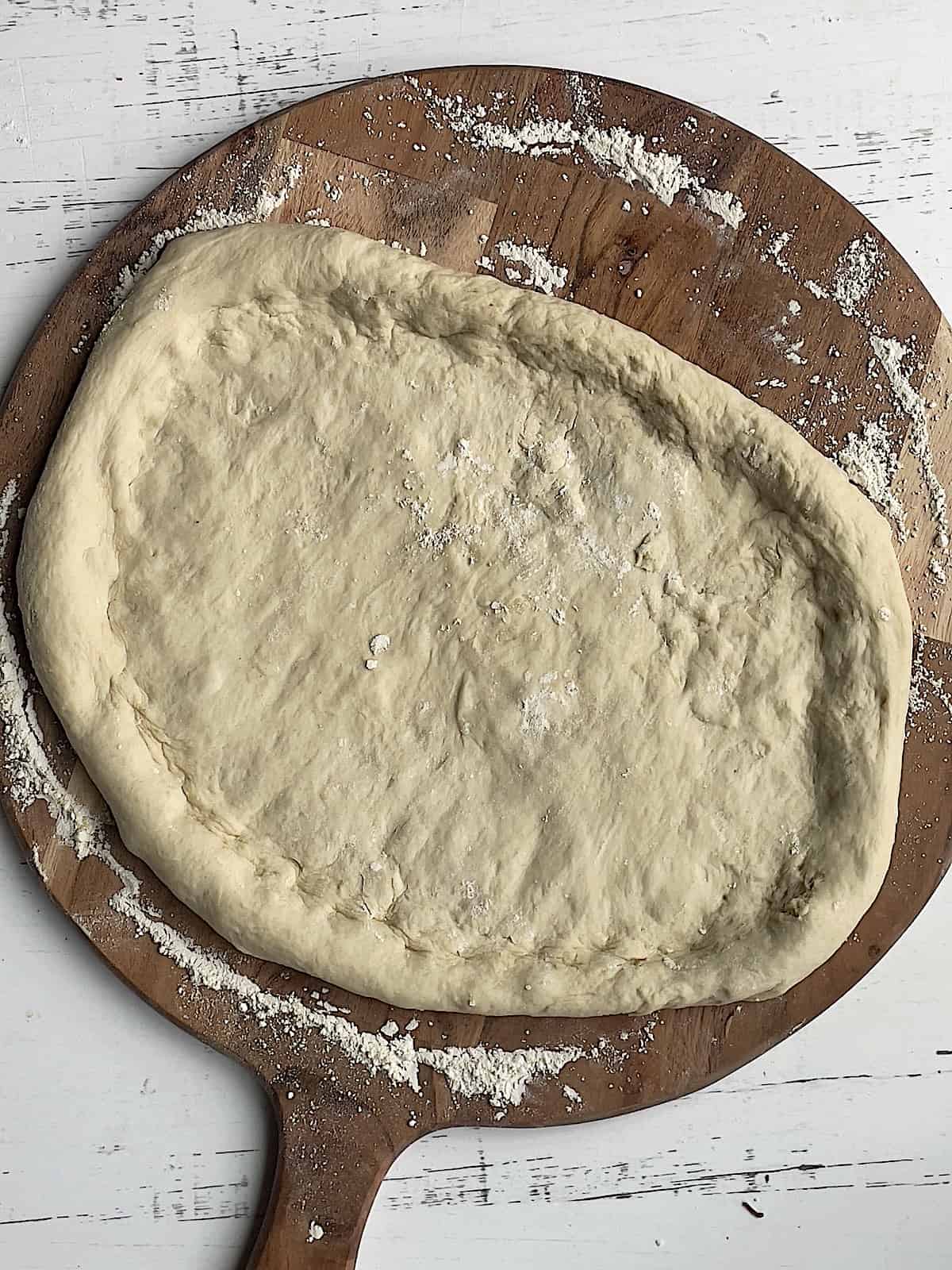
STEP 2: Cover a pizza peel with a generous amount of flour (this keeps the dough from sticking so you can transfer it easily to the hot stone). Place one ball of dough onto the floured peel and begin stretching it into the shape of a circle. Do this by pushing down on the middle of the dough without touching the edges. Push the dough outward until it forms a 12 inch circle with a ½ to 1 inch raised edge. It's important to keep from pressing down on the edge (the crust). If you press the edges flat, you'll let out the gasses that create an airy and bubbly pizza crust.
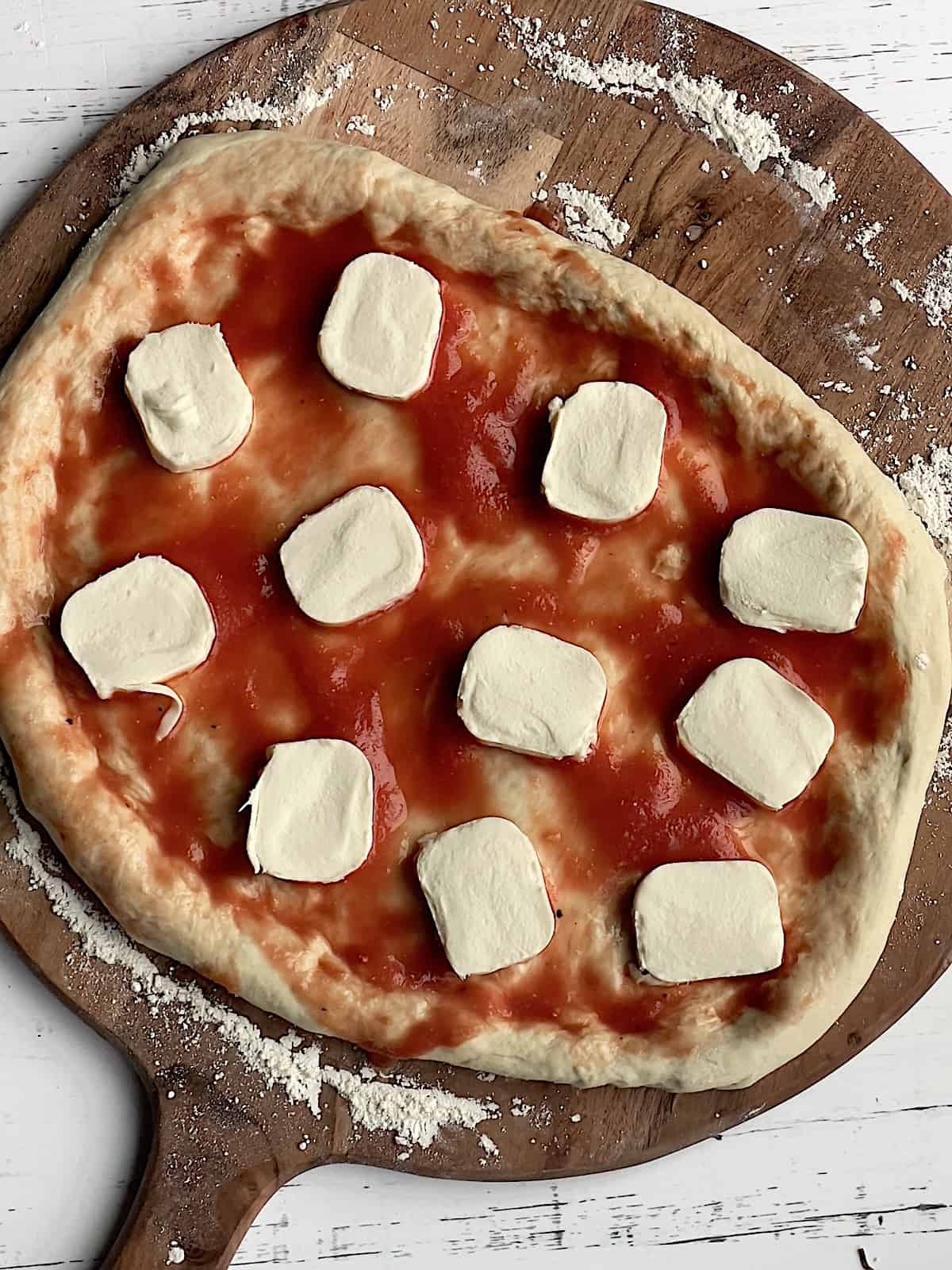
STEP 3: Use a blender to puree the plum tomatoes until smooth, about 30 seconds. Season with a few sprinkles of sea salt and twists of freshly ground black pepper. Working quickly, spread about ⅓ cup of pureed tomato sauce onto the pizza without pressing down on the dough. Evenly space half of the sliced mozzarella cheese on top of the sauce. Lightly brush some of the edges with sauce to create a golden crust.

STEP 4: Now cover the pizza stone with a generous amount of cornmeal. Carefully slide the pizza off the peel and onto the stone (do not remove it from the oven). If the pizza becomes stuck, gently guide it off with a spatula. The longer the pizza is left uncooked on the peel, the greater chance it has of sticking. Bake for 14 minutes, or until the cheese is bubbly and beginning to brown and the crust is golden brown.
Repeat steps 2-4 for the second pizza, then enjoy!
Recipe Tips
- Don't remove the pizza stone from the oven when the pizzas are done baking. Let it cool in the oven. Once cooled, brush off and discard the cornmeal, any crumbs, and cheese. Do not wash or get the pizza stone wet.
- Do not use a rolling pin to roll out the dough. This will flatten the edges, releasing all the gases needed to create a thick bubbly crust. Also make sure that you don't press down on the very edges that will eventually be the crust!
- Shaping and assembling the pizza on a highly floured surface is key to getting it not to stick to the surface and easily transferring it to the pizza stone. Just as important is using lots of cornmeal on the pizza stone so that it doesn't stick while baking.
- Don't rush the fermentation period. That authentic pizza flavor comes from a dough that is left to ferment for about 24 hours in a cool place. If you're in a rush, it's fine to shorten the time but don't expect the same flavor as dough that's fermented for the entire time.
Recipe

Authentic Neapolitan Pizza Dough Recipe
Equipment
- pizza peel
- pizza stone
- large bowl
- kitchen towel
- bread machine optional
- electric stand mixer optional
Ingredients
Pizza Dough
- 1 ½ cup warm water (110-120°)
- 1½ teaspoon yeast active dry or instant
- ½ tablespoon sugar
- 2 tablespoon olive oil
- 4 cups 00 flour
- 1½ teaspoon sea salt
Toppings
- 15 oz plum tomatoes canned
- sea salt
- freshly ground black pepper
- 16 oz fresh mozzarella cheese sliced
- fresh basil leaves
- grated parmesan cheese
Instructions
Making The Dough
- By Hand: Add the warm water, yeast, and sugar to a large bowl or the bowl of an electric stand mixer. Let sit for 2 minutes, then stir. Add the olive oil, 00 flour and sea salt. Mix with a spatula until a thick dough has formed. Transfer the dough to a floured surface and knead with your hands until a smooth and slightly sticky dough has formed, about 5 minutes. Shape the dough into a ball, put back into the bowl and cover with a heavy towel. Let rise in a warm place for 60 minutes. Then follow the instructions below for fermenting.
- Bread Machine: Add the ingredients into the bread maker pan in the order recommended by your manufacturer, select the dough/pizza dough setting and 2 pound loaf, and press start (if you've cut the recipe in half to make 1 pizza, choose 1 pound loaf). The dough setting takes between 90 and 100 minutes on most bread machines. When the cycle is complete, remove the dough and follow the instructions below for fermenting.*Pay careful attention to the dough during the first 10 minutes of kneading. If the dough appears too dry and it's not shaping into a smooth springy ball, add more water 1 tablespoon at a time. If the dough is too wet, add more flour 1 tablespoon at a time.
- Fermentation: Separate the dough to make 2 equal pieces. Punch them down a few times and shape into balls. Put into two oiled gallon freezer bag or bowls covered tightly with plastic wrap. Transfer to the fridge and let rest for 12-24 hours. Remove from the fridge and bring to room temperature 4 hours before shaping and cooking.
Cooking
- Place a pizza stone into the oven and preheat to 500° Fahrenheit. Once preheated, begin creating the pizza. The stone should remain in the heated oven for about 20 minutes before putting on the pizza. Cover a pizza peel with a generous amount of flour (this keeps the dough from sticking so you can transfer it easily to the hot stone). Place one ball of dough onto the floured peel and begin stretching it into the shape of a circle. Do this by pushing down on the middle of the dough without touching the edges. Push the dough outward until it forms a 12 inch circle with a ½ to 1 inch raised edge. It's important to keep from pressing down on the edge (the crust). If you press the edges flat, you'll let out the gasses that create an airy and bubbly pizza crust.
- Use a blender to puree the plum tomatoes until smooth, about 30 seconds. Season with a few sprinkles of sea salt and twists of freshly ground black pepper. Working quickly, spread about ⅓ cup of pureed tomato sauce onto the dough without pressing down. Evenly space half of the sliced mozzarella cheese on top of the sauce. Lightly brush some of the edges with sauce to create a golden crust.
- Cover the pizza stone with a generous amount of cornmeal. Carefully slide the pizza off the peel and onto the stone (do not remove it from the oven). If the pizza becomes stuck, gently guide it off with a spatula. The longer the pizza is left uncooked on the peel, the greater chance it has of sticking. Bake for 14 minutes, or until the cheese is bubbly and beginning to brown and the crust is golden brown.
- Remove from the pizza stone using the pizza peel. Top with fresh basil leaves and a drizzle of olive oil. Lightly sprinkle with grated parmesan cheese and sea salt. Let cool for 5 minutes before slicing and serving. Repeat steps 1-4 for the second pizza.


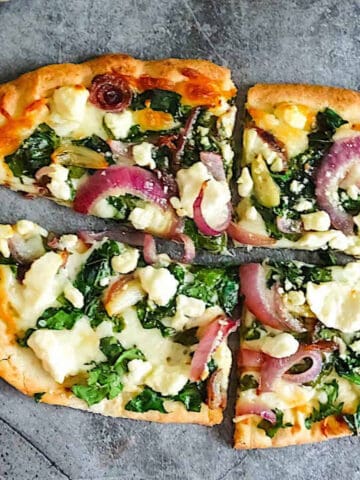
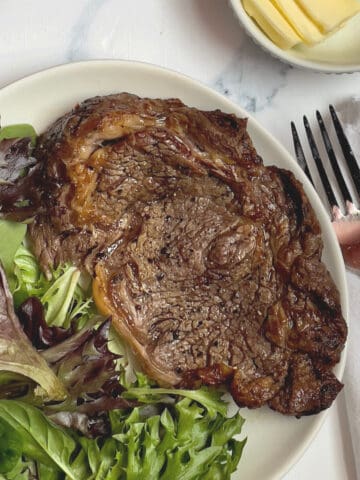

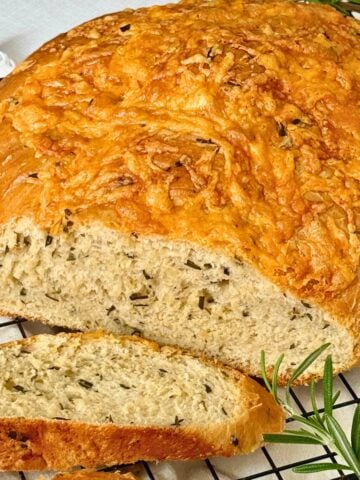
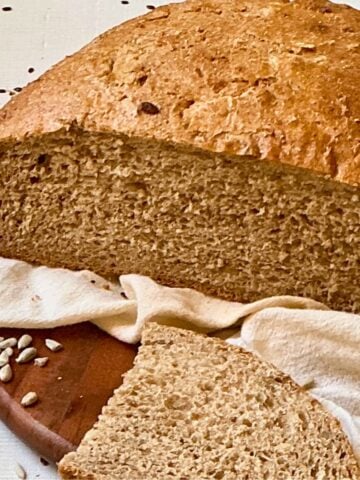
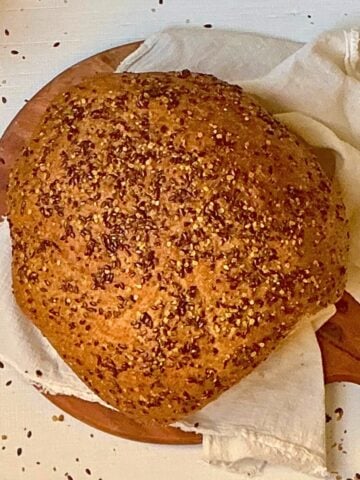
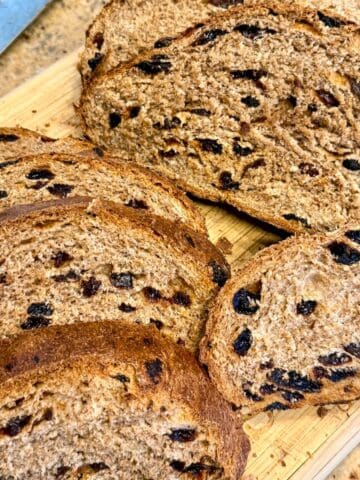
Pattio says
At what point do you freeze the dough? After fermentation before shaping? After shaping? After cooking?
Kristina says
You should freeze pizza dough after fermentation. Let it defrost on the counter or fridge and let it come to room temperature before shaping and cooking.
Chelle says
My family absolutely LOVES this recipe. We add a half teaspoon salt more, but everything is kept as written. It freezes well, too! We make up several batches in the bread machine and freeze them. They make PHENOMENAL cheesy breadsticks as well. Couldn't recommend this recipe enough.
Kristina says
Thanks Chelle! I am glad you are all enjoying it so much.